Investigating the Energy Dissipation Mechanism of Piano Key Weir: An Integrated Approach Using Physical and Numerical Modeling
Abstract
:1. Introduction
2. Materials and Methods
2.1. Experimental Setup
2.2. PKW Model
2.3. Numerical Setup
2.4. Initial Condition and Grid Convergence
3. Results and Discussion
3.1. Verification of Discharge and Free Surface
3.2. Flow Patterns
3.3. Discharge of Each Overflow Edges
3.4. Energy Dissipation Characteristics
3.5. Energy Dissipation Mechanism
4. Conclusions
- (1)
- PKW is very efficient in dissipating energy, with an energy dissipation rate of 70% at the low water heads. As the water head increases, the energy dissipation effect weakens, with an energy dissipation rate of 40% at the high water heads.
- (2)
- The energy dissipation rates along the upstream and downstream of the PKW are relatively high, and the variation law of energy along the way was consistent under the different water heads. As the water head increases, the energy dissipation rate along the way decreases.
- (3)
- The energy dissipation of the PKW can be divided into three stages: the hindering of the upstream flow and decreasing the trend of increasing the flow velocity in front of the weir; the collision and mixing of water flow inside the outlet key reducing the energy; the water tongues diffusing, becoming aerated, and falling into the downstream, consuming most of the remaining energy.
Author Contributions
Funding
Data Availability Statement
Conflicts of Interest
References
- Vallarino-Castillo, R.; Negro-Valdecantos, V.; del Campo, J.M. A Systematic Review of Oceanic-Atmospheric Variations and Coastal Erosion in Continental Latin America: Historical Trends, Future Projections, and Management Challenges. J. Mar. Sci. Eng. 2024, 12, 1077. [Google Scholar] [CrossRef]
- Nageswaran, P.; Oetjen, J.; Harish, S.; Sriram, V.; Sundar, V.; Schüttrumpf, H. Buffer Blocks as Wave Energy Dissipators: Flow Depth Reduction. J. Mar. Sci. Eng. 2024, 12, 1145. [Google Scholar] [CrossRef]
- Haghiabi, A.H.; Nou, M.R.G.; Parsaie, A. The energy dissipation of flow over the labyrinth weirs. Alex. Eng. J. 2022, 61, 3729–3733. [Google Scholar] [CrossRef]
- Singh, D.; Kumar, M. Effect of the inlet-to-outlet key width ratio of Piano Key Weir on its hydraulic behaviour. Flow Meas. Instrum. 2023, 91, 102342. [Google Scholar] [CrossRef]
- Idrees, A.K.; Al-Ameri, R. Investigation of flow characteristics and energy dissipation over new shape of the trapezoidal labyrinth weirs. Flow Meas. Instrum. 2023, 89, 102276. [Google Scholar] [CrossRef]
- Machiels, O.; Erpicum, S.; Dewals, B.J.; Archambeau, P.; Pirotton, M. Experimental observation of flow characteristics over a Piano Key Weir. J. Hydraul. Res. 2011, 49, 359–366. [Google Scholar] [CrossRef]
- Anderson, R.M.; Tullis, B.P. Comparison of Piano Key and Rectangular Labyrinth Weir Hydraulics. J. Hydraul. Eng. 2012, 138, 358–361. [Google Scholar] [CrossRef]
- Kumar, B.; Ahmad, Z. Scour Downstream of a Piano Key Weir with and without a Solid Apron. J. Irrig. Drain. Eng. 2022, 148, 04021066. [Google Scholar] [CrossRef]
- Jüstrich, S.; Pfister, M.; Schleiss, A.J. Mobile riverbed scour downstream of a piano key weir. J. Hydraul. Eng. 2016, 142, 40160431–401604312. [Google Scholar] [CrossRef]
- Shen, X.; Oertel, M. Influence of Piano Key Weir Crest Shapes on Flow Characteristics, Scale Effects, and Energy Dissipation for In-Channel Application. J. Hydraul. Eng. 2023, 149, 04023010. [Google Scholar] [CrossRef]
- Eslinger, K.R.; Crookston, B.M. Energy Dissipation of Type a Piano Key Weirs. Water 2020, 12, 1253. [Google Scholar] [CrossRef]
- Rajaei, A.; Esmaeili Varaki, M.; Shafei Sabet, B. Experimental investigation on local scour at the downstream of grade control structures with labyrinth planform. ISH J. Hydraul. Eng. 2018, 26, 457–467. [Google Scholar] [CrossRef]
- Li, S.; Li, G.; Jiang, D.; Ning, J. Influence of auxiliary geometric parameters on discharge capacity of piano key weirs. Flow Meas. Instrum. 2020, 72, 101719. [Google Scholar] [CrossRef]
- Singh, D.; Kumar, M. Study of the Energy Dissipation over the Type-A Piano Key Weir. KSCE J. Civ. Eng. 2023, 27, 1568–1584. [Google Scholar] [CrossRef]
- Singh, D.; Kumar, M. Energy dissipation of flow over the type-B Piano Key Weir. Flow Meas. Instrum. 2022, 83, 102109. [Google Scholar] [CrossRef]
- Hu, H.; Qian, Z.; Yang, W.; Hou, D.; Du, L. Numerical study of characteristics and discharge capacity of piano key weirs. Flow Meas. Instrum. 2018, 62, 27–32. [Google Scholar] [CrossRef]
- Crookston, B.M.; Tullis, B.P. Hydraulic Design and Analysis of Labyrinth Weirs. II: Nappe Aeration, Instability, and Vibration. J. Irrig. Drain. Eng. 2013, 139, 371–377. [Google Scholar] [CrossRef]
- Li, S.; Li, G.; Jiang, D. Physical and Numerical Modeling of the Hydraulic Characteristics of Type-A Piano Key Weirs. J. Hydraul. Eng. 2020, 146, 06020004. [Google Scholar] [CrossRef]
- Yazdi, A.M.; Hoseini, S.; Nazari, S.; Fazeli, M. Numerical and experimental analysis of scour downstream of piano key weirs. Sādhanā 2022, 47, 189. [Google Scholar] [CrossRef]
- Vermeulen, J.; Laugier, F.; Faramond, L.; Gille, C.; Erpicum, S.; Laugier, F.; Boillat, J.-L.; Pirotton, M.; Reverchon, B.; Schleiss, A. Lessons learnt from design and construction of EDF first Piano Key Weirs. In Labyrinth and Piano Key Weirs; CRC Press: Boca Raton, FL, USA, 2011; pp. 215–224. [Google Scholar]
- Khanh, M.; Hien, T.; Hai, N.; Erpicum, S.; Laugier, F.; Boillat, J.-L.; Pirotton, M.; Reverchon, B.; Schleiss, A. Main results of the P.K weir model tests in Vietnam (2004 to 2010). In Labyrinth and Piano Key Weirs; CRC Press: Boca Raton, FL, USA, 2011; pp. 191–198. [Google Scholar]
- Ribeiro, M.L.; Pfister, M.; Schleiss, A.J.; Boillat, J.-L. Hydraulic design of a-type piano key weirs. J. Hydraul. Res. 2012, 50, 400–408. [Google Scholar] [CrossRef]
- Farhadi, H.; Sabzevari, T.; Moghadam, M.K.; Noroozpour, S. The Effect of the Central Angle and Height of Arced Piano Key Weir on the Discharge Coefficient. Iran. J. Sci. Technol. Trans. Civ. Eng. 2022, 47, 599–607. [Google Scholar] [CrossRef]
- Abhash, A.; Pandey, K.K. A review of Piano Key Weir as a superior alternative for dam rehabilitation. ISH J. Hydraul. Eng. 2020, 28 (Suppl. S1), 541–551. [Google Scholar] [CrossRef]
- Ouamane, A.; Erpicum, S.; Laugier, F.; Boillat, J.-L.; Pirotton, M.; Reverchon, B.; Schleiss, A. Nine years of study of the Piano KeyWeir in the university laboratory of Biskra “lessons and reflections”. In Labyrinth and Piano Key Weirs; CRC Press: Boca Raton, FL, USA, 2011; pp. 51–58. [Google Scholar]
- Shen, X.; Oertel, M. Comparative Study of Nonsymmetrical Trapezoidal and Rectangular Piano Key Weirs with Varying Key Width Ratios. J. Hydraul. Eng. 2021, 147, 04021045. [Google Scholar] [CrossRef]
- Leite Ribeiro, M.; Bieri, M.; Boillat, J.-L.; Schleiss, A.J.; Singhal, G.; Sharma, N. Discharge Capacity of Piano Key Weirs. J. Hydraul. Eng. 2012, 138, 199–203. [Google Scholar] [CrossRef]
- Lempérière, F. New labyrinth weirs triple the spillways discharge. Water Energy Int. 2011, 68, 77–78. [Google Scholar]
- Trucano, T.; Post, D. Verification and Validation in Computational Science and Engineering. Comput. Sci. Eng. 2004, 6, 8–9. [Google Scholar] [CrossRef]
- Deepak, S.; Munendra, K. Gene expression programming for computing energy dissipation over type-B piano key weir. Renew. Energy Focus 2022, 41, 230–235. [Google Scholar]
- Koken, M.; Aydin, I.; Ademoglu, S. An iterative hydraulic design methodology based on numerical modeling for piano key weirs. J. Hydro-Environ. Res. 2022, 40, 131–141. [Google Scholar] [CrossRef]
- Karimi Chahartaghi, M.; Nazari, S.; Mahmoodian Shooshtari, M. Experimental and numerical simulation of arced trapezoidal piano key weirs. Flow Meas. Instrum. 2019, 68, 101576. [Google Scholar] [CrossRef]
- Mohammad Karimi Chahartaghi, P.D.; Nazari, S.; Shooshtari, M.M. Experimental Study on Local Scour Downstream of Arced Piano-Key Weirs. J. Irrig. Drain. Eng. 2023, 149, 04023027. [Google Scholar] [CrossRef]
- Akbar, S.; Shadi, A.M. Hydromechanics of the Asymmetric Trapezoidal Piano Key and Labyrinth Weirs. J. Irrig. Drain. Eng. 2023, 149, 04023023. [Google Scholar]
- Seyedjavad, M.; Naeeni, S.O.; Saneie, M. Flow velocity pattern around trapezoidal piano key side weirs. Flow Meas. Instrum. 2020, 76, 101847. [Google Scholar] [CrossRef]
- Daneshfaraz, R.; Sadeghi, H.; Ghaderi, A.; Abraham, J.P. Characteristics of hydraulic jump and energy dissipation in the downstream of stepped spillways with rough steps. Flow Meas. Instrum. 2024, 96, 102506. [Google Scholar] [CrossRef]
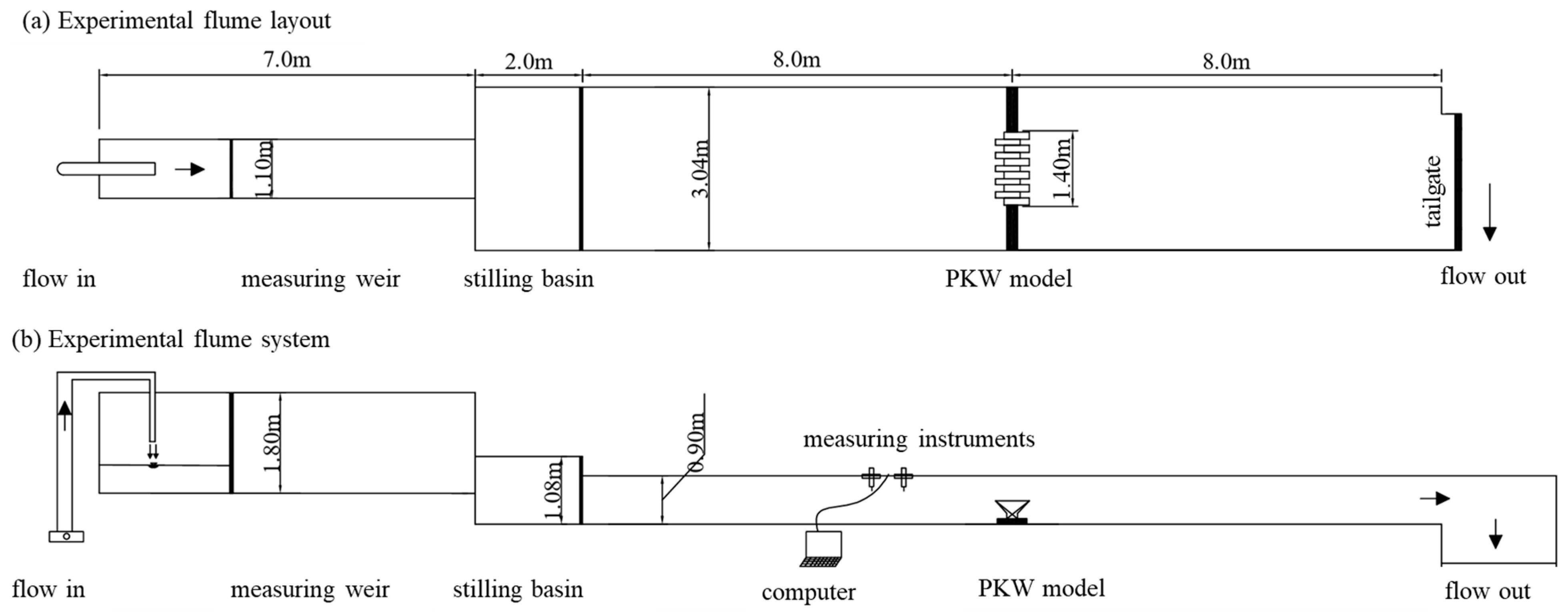
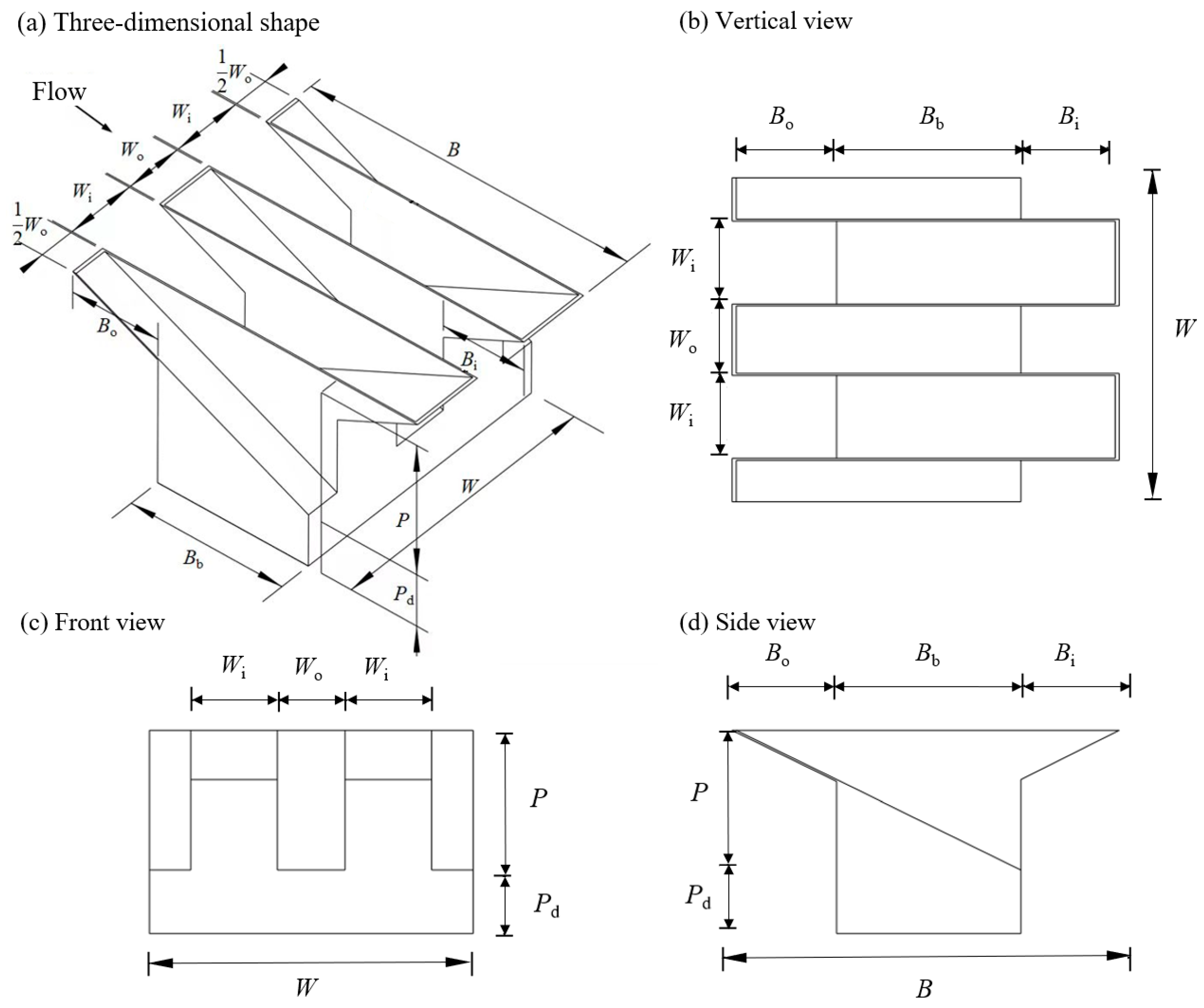
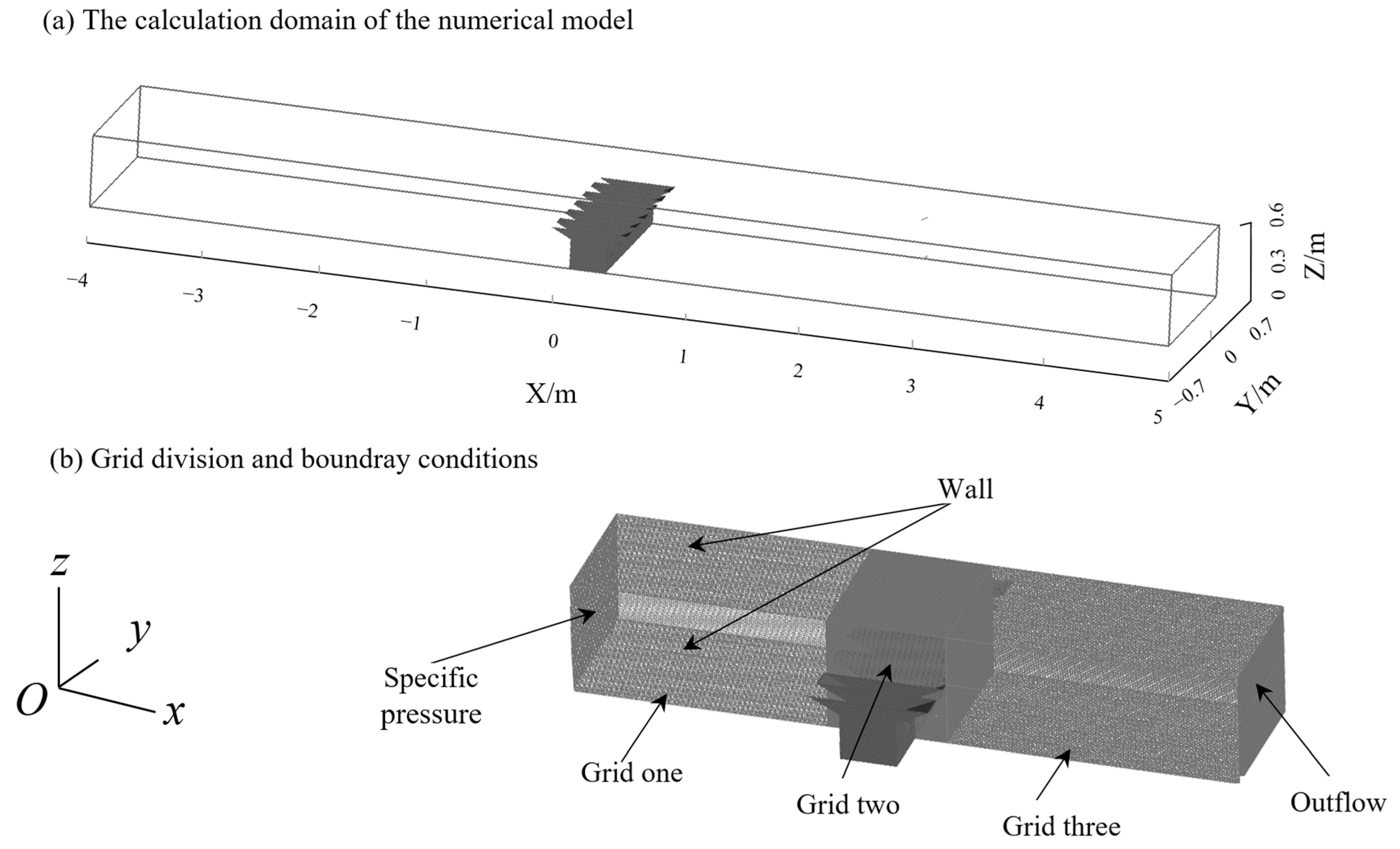
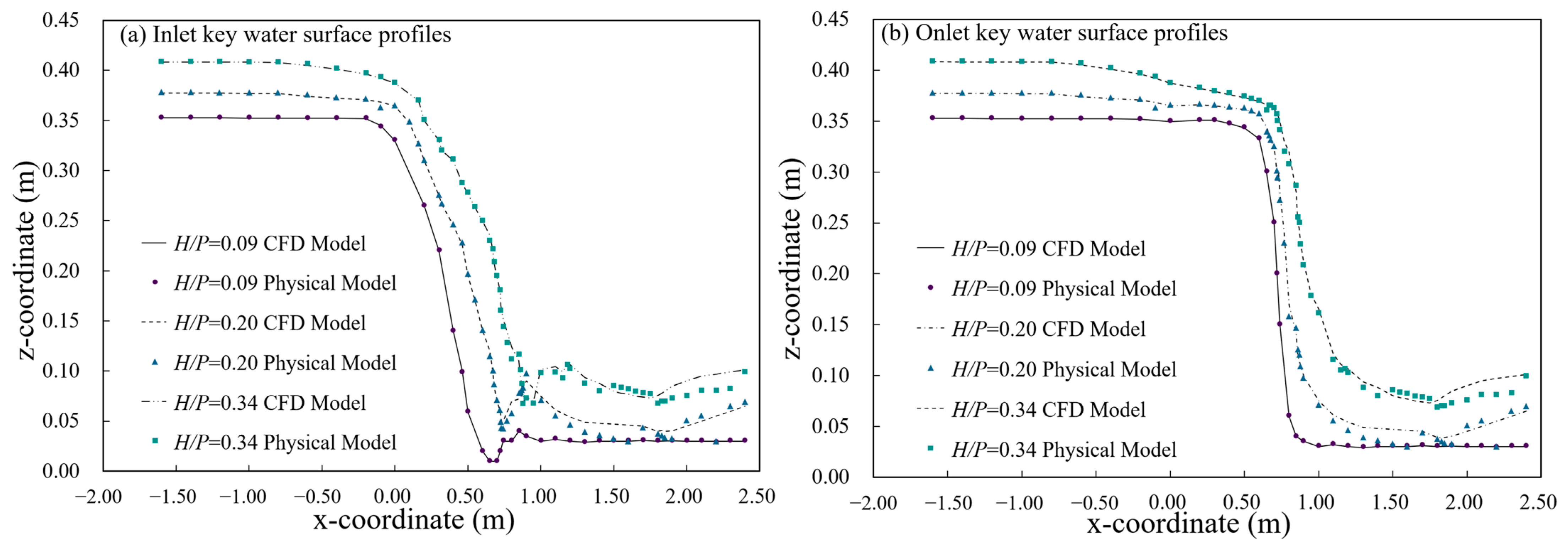


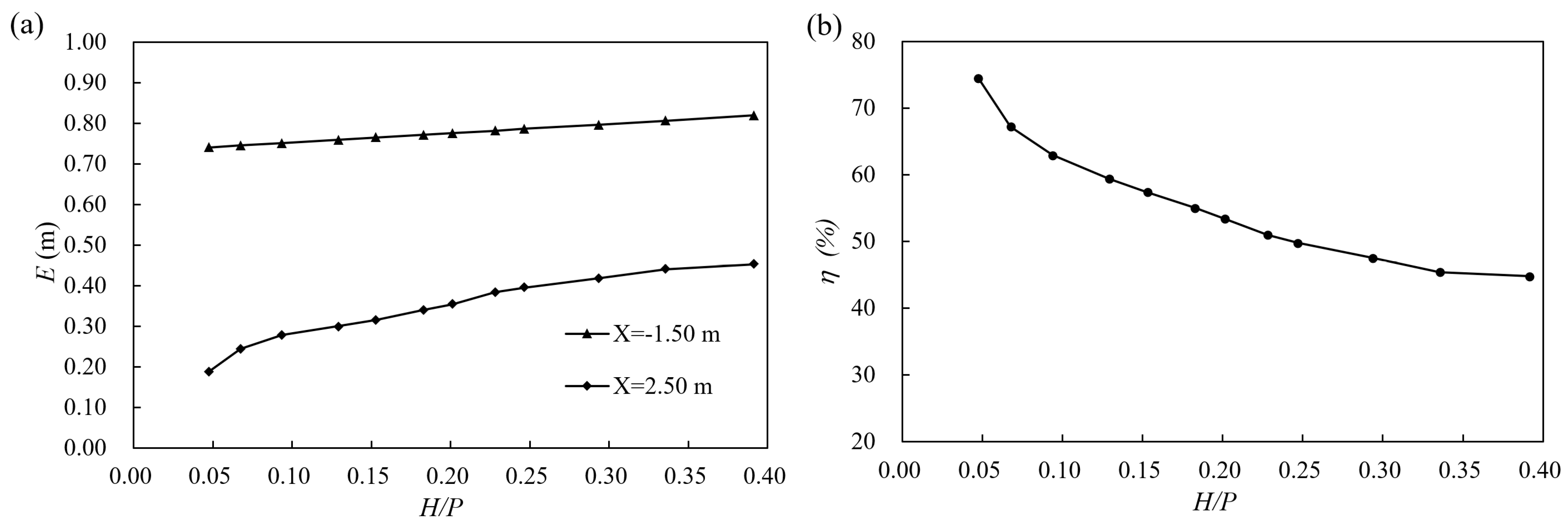




| Parameters | Size |
|---|---|
| L | 7.000 |
| W | 1.400 |
| Wi | 0.135 |
| Wo | 0.108 |
| B | 0.640 |
| Bo | 0.170 |
| Bi | 0.170 |
| Bb | 0.300 |
| P | 0.230 |
| Pd | 0.100 |
| Grid Size (mm) | R = Di/Di+1 | Q (L/s) | σ | GCI (%) |
|---|---|---|---|---|
| 9 | -- | 50.58 | -- | -- |
| 7.5 | 1.2 | 52.29 | 5.39 | 3.73 |
| 4 | 1.87 | 56.61 | 2.32 | 1.09 |
| Groups | H/P | QEXP (L/s) | QCFD (L/s) | Relative Value % |
|---|---|---|---|---|
| 1 | 0.05 | 15.4 | 15.92 | 3.38 |
| 2 | 0.07 | 25.0 | 26.30 | 1.56 |
| 3 | 0.09 | 40.0 | 39.46 | −1.35 |
| 4 | 0.13 | 60.0 | 58.61 | −2.32 |
| 5 | 0.15 | 75.0 | 73.18 | −2.43 |
| 6 | 0.18 | 90.0 | 87.92 | −2.31 |
| 7 | 0.20 | 100 | 99.74 | −0.26 |
| 8 | 0.23 | 115 | 113.77 | −1.07 |
| 9 | 0.25 | 125 | 124.13 | −0.69 |
| 10 | 0.30 | 150 | 151.64 | 1.09 |
| 11 | 0.34 | 170 | 165.77 | −2.49 |
| 12 | 0.39 | 200 | 197.28 | −1.36 |
Disclaimer/Publisher’s Note: The statements, opinions and data contained in all publications are solely those of the individual author(s) and contributor(s) and not of MDPI and/or the editor(s). MDPI and/or the editor(s) disclaim responsibility for any injury to people or property resulting from any ideas, methods, instructions or products referred to in the content. |
© 2024 by the authors. Licensee MDPI, Basel, Switzerland. This article is an open access article distributed under the terms and conditions of the Creative Commons Attribution (CC BY) license (https://creativecommons.org/licenses/by/4.0/).
Share and Cite
Li, Z.; Yang, F.; Han, C.; Fan, Z.; Yu, K.; Han, K.; Wu, J. Investigating the Energy Dissipation Mechanism of Piano Key Weir: An Integrated Approach Using Physical and Numerical Modeling. Water 2024, 16, 2620. https://doi.org/10.3390/w16182620
Li Z, Yang F, Han C, Fan Z, Yu K, Han K, Wu J. Investigating the Energy Dissipation Mechanism of Piano Key Weir: An Integrated Approach Using Physical and Numerical Modeling. Water. 2024; 16(18):2620. https://doi.org/10.3390/w16182620
Chicago/Turabian StyleLi, Zixiang, Fan Yang, Changhai Han, Ziwu Fan, Kaiwen Yu, Kang Han, and Jingxiu Wu. 2024. "Investigating the Energy Dissipation Mechanism of Piano Key Weir: An Integrated Approach Using Physical and Numerical Modeling" Water 16, no. 18: 2620. https://doi.org/10.3390/w16182620






